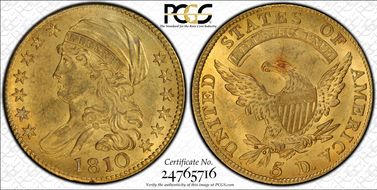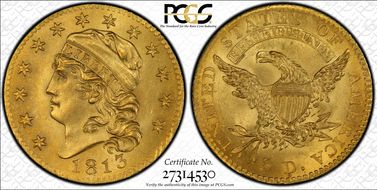Jesh 的钱币相册
CAC. JR-5, R.1. The 4 in the date shows the crossbar partially broken off, with a sharp pointed fragment still visible. On the reverse, the last A in AMERICA is joined to the C and to the arrowhead. The lustrous surfaces of this near-Gem display splashes of forest-green and lavender, more extensive and deeper on the obverse. This sharply struck piece has been well cared for. Population: 18 in 64, 11 finer (11/11).
CAC. JR-5, R.1. The 4 in the date shows the crossbar partially broken off, with a sharp pointed fragment still visible. On the reverse, the last A in AMERICA is joined to the C and to the arrowhead. The lustrous surfaces of this near-Gem display splashes of forest-green and lavender, more extensive and deeper on the obverse. This sharply struck piece has been well cared for. Population: 18 in 64, 11 finer (11/11).
(CAC) O-131, R.2. The obverse with die line above the LI of LIBERTY, the reverse with "Leaning 0" in the denomination. This is a gorgeous near-Gem that is ideal for the type collector seeking a high-end Bust half. The strike is solid, if a trifle incomplete on the highest design elements, and the luster is warm silver overall with gold and violet elements at the borders. Purchased as MS64.
(CAC) O-131, R.2. The obverse with die line above the LI of LIBERTY, the reverse with "Leaning 0" in the denomination. This is a gorgeous near-Gem that is ideal for the type collector seeking a high-end Bust half. The strike is solid, if a trifle incomplete on the highest design elements, and the luster is warm silver overall with gold and violet elements at the borders. Purchased as MS64.
CAC. Purchased as MS63/CAC. State c/b. Die clashing is seen most notably at the top of the obverse above the cap. This common early gold type coin has an estimated survival of 500 to 750 pieces, out of an a total of 75,000 to 90,000 originally minted. Of course, the vast majority of those produced were melted from the date of issue through 1834, at which time gold coins became worth less than their intrinsic value. This is a lovely orange-gold example whose color is only interrupted by a spot of copper (from improper mixture of the gold/copper alloy in that area) over the eagle's eye. The devices are sharply struck throughout, and there are no obvious or detracting abrasions. (Upgrade from MS63) EX: Oliver Collection PCGS 1/35 (05/15)
CAC. Purchased as MS63/CAC. State c/b. Die clashing is seen most notably at the top of the obverse above the cap. This common early gold type coin has an estimated survival of 500 to 750 pieces, out of an a total of 75,000 to 90,000 originally minted. Of course, the vast majority of those produced were melted from the date of issue through 1834, at which time gold coins became worth less than their intrinsic value. This is a lovely orange-gold example whose color is only interrupted by a spot of copper (from improper mixture of the gold/copper alloy in that area) over the eagle's eye. The devices are sharply struck throughout, and there are no obvious or detracting abrasions. (Upgrade from MS63) EX: Oliver Collection PCGS 1/35 (05/15)
CAC. BD-1, R.2. Bass-Dannreuther Die State b/b. The Capped Bust Left design was modified in 1813, with the bust and eagle restyled and the stars arranged in a continuous arc above the portrait, instead of the 7x6 arrangement of the previous design. A substantial mintage of 95,428 pieces was achieved, with only two die varieties known for the date. This coin represents the more available BD-1 variety, identified by the position of the first S in STATES over the right side of E in PLURIBUS. The BD-1 is the only readily available date and variety of this design type, making it a favorite choice of type collectors. The BD-1 probably accounted for 60,000-75,000 pieces of the reported mintage, with a surviving population of 450-650 examples in all grades. John Reich's secret signature star punch, with the notched outside point, was used on star 13. The obverse die was also used to strike the BD-2 variety of this date, but the BD-1 is the only use of the reverse die. As a date, 1813 half eagles have been avidly collected since the 1850s, with an example appearing in lot 187 of the A.C. Kline Sale (Moses Thomas & Sons, 6/1855). More recent sales include the appearance of the present coin in lot 5093 of the FUN Signature (Heritage, 1/2011), which realized $48,875. The coin offered here is a spectacular near-Gem example, with pleasing yellow-gold surfaces and strong rose highlights at the peripheries. The design elements are sharply detailed, and vibrant mint luster beams on both sides. A few light adjustment marks appear on Liberty's cheek on close inspection, but they have little impact on the coin's extraordinary visual appeal. Population: 48 in 64, 3 finer (6/12). 48/4 (1/14)


























